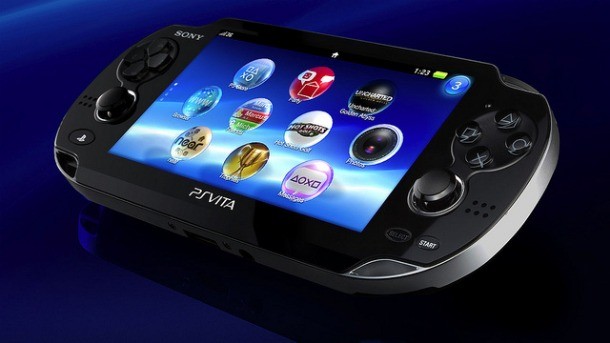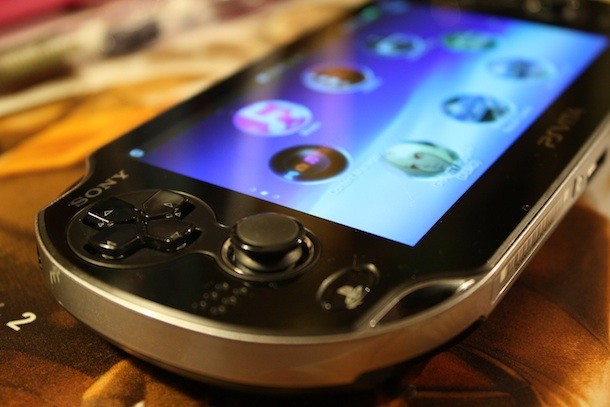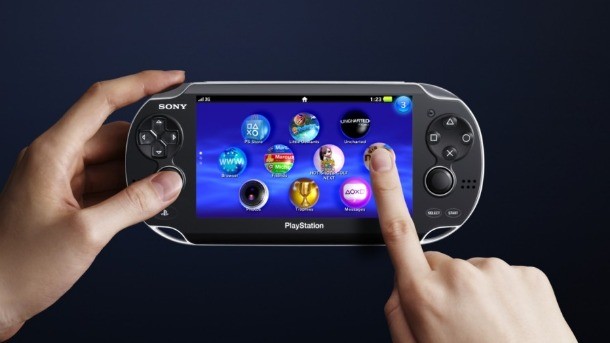Please support Game Informer. Print magazine subscriptions are less than $2 per issue
PlayStation Vita Review

Is Sony’s new handheld gaming platform worth the price of admission? We break down its performance and hand out a final grade in anticipation of the February 22 release.
Display
The screen is the first thing you will notice about the Vita, and understandably so. Though it doesn’t have the resolution of the iPhone 4’s Retina display, this five-inch, 960x544 resolution OLED screen still delivers bright, colorful, and stunning visuals. The graphical fidelity is markedly better than the PSP and PlayStation 2, but not quite on the same level as the PlayStation 3. The fact that the image quality is even in the neighborhood of the high-powered console is an incredible feat in and of itself. During my review I saw no hints of ghosting or tearing, frequent problems on the PSP. Video playback looked great on the screen as well.
Design
The sleek and sturdy Vita feels great in your hands. It’s larger than any of the other competing handheld devices (including mobile phones), but it’s never unwieldy. It doesn’t dig into your palms, and the chassis is rounded on the sides so there are no uncomfortable sharp edges.
Though it has a similar layout, the buttons feel different compared to the DualShock 3 controller. The face buttons click responsively but lack the soft, pressure-sensitive push of the PlayStation 3 buttons. The shoulder buttons feel more similar to the later PSP models, offering the slight illusion of a trigger without actually having it. The d-pad has the same satisfying click of the face buttons, but where the DualShock 3 breaks the d-pad into four separate buttons, the Vita has one solid piece of plastic with no separation. Thankfully, this design doesn’t hinder the responsiveness.
The importance of the built-in dual control sticks cannot be understated; it’s the primary element that sets the Vita apart from the PSP, the 3DS (which only offers a second analog stick via a peripheral), and game-friendly mobile phones. It also makes you forget you are playing a handheld. These sticks aren’t replicas of those on the PlayStation 3 controller, but they’re close. They lack the same range of movement and don’t double as buttons when pressed, but they feel perfect for the handheld system. They sit close enough to the system’s surface that they don’t feel like they will catch on things when the device is hastily stuffed into a backpack or pocket. The one minor downside of the control sticks is their close proximity to the d-pad and the face buttons. Jumping between the X button and the right control stick may prove difficult to gamers with larger hands.
Battery Life
The Vita tuckers out after about four to five hours of continuous play, which is on par with the PSP but far below the DS battery life. The Vita does beat the 3DS by the large margin, however, offering longer continuous play and a longer sleep time, even with a paused game in progress.
User Interface
The menus should look familiar to most smartphone users, as every available piece of software gets its own specific application. Visually, apps are displayed as circular discs that resemble bubbles. They can be moved around, but cannot be bundled or organized in any other fashion. When you open an application, a shortcut is created that can be reached by swiping the screen to the left. These shortcuts can be removed by simulating a peeling motion from the top of the screen to the bottom left. Removing the application shortcuts is instantly understandable and executable with no tutorial.
Some of the assorted applications can run simultaneously, such as games and the trophy viewer application. You can’t do things like begin playing a game on a cartridge, and then open a game on the memory card, however, which is fine because I don’t foresee a need to have multiple games -running at once. In regard to software that can be run simultaneously, there is no XMB like the PSP and the PlayStation 3. To multitask, you have to pause a game, close the software, and then open the other app. This means there is no quick way to check trophies, friends lists, or messages. Checking these things doesn’t interrupt your game; it just slows you down, so it’s a small complaint.
When you log into your PlayStation Network account on the Vita, your account is connected to that Vita. Short of factory resetting the system, there is no way to share multiple accounts on one Vita like you can on a PlayStation 3.The Vita also includes a web browser. It’s about as functional here as it was on the PSP – which is to say not very much at all. It’s a useless addition because it's definitely inferior to browsing with your smartphone.

Touchscreen
When Sony first demonstrated the Vita, it seemed as though it had created a handheld video game console with touchscreen elements. But the more time I spend with the system, the more it feels like a touchscreen device with video game elements. Outside of playing games, everything is controlled by the touchscreen: menu navigation, setting changes, etc. Considering how much you touch the screen, it’s a shame it is so susceptible to smudging. The back of the system also serves as a touchpad as well, but it cannot be used to navigate the menus. The face buttons don’t work for menu navigation, either. This means there is no way to avoid touching the pristine screen and turning it into a giant smudge mark.
As you would expect from a device in the post-iPhone era, the touchscreen works flawlessly. It’s a difficult theory to test, but the Vita touchscreen even seems more responsive than Apple’s offerings, which is a testament to its quality. This multi-touch display is blazing fast. The touch abilities of the back of the handheld fare just as well as the front. The tilt and motion sensing seem more responsive than Apple’s devices, as well.
Camera
When it comes to mobile gaming devices, every manufacturer shoves in a camera, but does anyone really use them? Did you take any photos on your DSi or your 3DS other than on the first day of owning the system? In all likelihood, you have a better or comparable camera on the phone in your pocket. Photos taken on the Vita’s 1.3-megapixel cameras look muddy and small. Outside of the cameras being used for augmented reality gameplay purposes, I doubt the forward and backward-facing cameras will get much use.
Multimedia
In the off chance that you take photos with your Vita, getting them off the system is a process. Sony offers a free downloadable content manager for the Vita that lets you move photos, video, and music on and off the system. It’s not the most intuitive software, but I’ve seen worse.
The simply titled Content Manager Assistant can be downloaded by heading here (and here for the Mac version). Once the software is downloaded, the Vita looks at the video, picture, and music folders on your computer and you can copy items from those folders to the Vita, or the other way around. It’s simpler than something like iTunes' complicated syncing mechanics, but still requires some strange folder navigation.
Summary
Our technological complaints about the Vita are relatively minor, but this impressive device will cost you. At $249 for the base, Wi-Fi-only model, the Vita is expensive. The need for purchasing a proprietary memory card further exacerbates the problem. It seems absurd that Sony didn’t include a few gigabytes of internal storage, because players can’t do much without a memory card. Even buying the non-3G model of the system with one game and the smallest memory card will set you back over $300. If you lose the included proprietary cable used for charging and connecting the Vita to a computer for file transfers, your only replacement option is an overpriced wire from Sony. It’s also worth noting that the battery cannot be replaced without replacing the entire system.
The Vita is not a flawless system, but when it comes to the important features that make a handheld gaming console worthwhile, it hits most of the notes. Incredible graphics, responsive touchscreen and tilt mechanics, and the extra control stick make the Vita one of the most well-rounded handhelds we’ve ever seen. Given its myriad input options, the Vita can satisfy the casual gamer used to playing games with a touchscreen and the much harder to please hardcore gamer who wants full control and amazing graphics.
With impressive launch titles like Uncharted: Golden Abyss, the game library shouldn’t be an issue for the Vita. The question is, are gamers still eager to purchase a $250 system and $40 games when they can easily find rewarding experiences for under $10 on their smartphones and tablets? If they don’t, it’s a sign of the times, not a knock on the Vita’s quality.
Final Grade: A-
Check below for a breakdown of some of the Vita's additional features.

Welcome Park
To show off new users what the Vita can do, Sony is including Welcome Park in every bundle. This series of minigames is designed to highlight every facet of the system. For instance, one game puts you in control of a skateboarder to learn how to use the tilt controls, while another tasks players to use the touchscreen to select numbers in a certain order. Other minigames showcase the microphone and camera capabilities as well. They’re all simple, but they do a great job of familiarizing users with the system and you can earn trophies by playing the games.
Apps
If you’re looking to expand the functionality of your Vita, you can download Facebook, Twitter, Skype, and FourSquare apps at launch. A Netflix app is coming to the Vita, and Sony hopes it will be available to download on the Vita’s release day. The interface was created to support many apps, so we expect to see many more gaming and non-gaming add-ons as the Vita moves into the future.
Breaking down the price
Hardware
PS Vita
Wi-Fi-only – $249.99
PS Vita Wi-Fi and 3G – $299.99
Memory cards
4GB – $19.99
8GB – $29.99
16GB – $59.99
32GB – $99.99
Data Plan (3G Model Only)
250MB – $14.99/mo. (no contract)
3GB – $30.00/mo. (no contract)
Games
$7.99-$49.99
Click the links below for our reviews:










